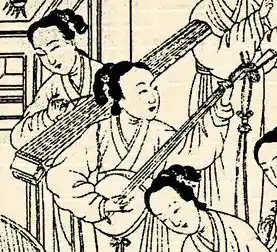| Classification | |
|---|---|
| Related instruments | |
| |
The yazheng (simplified Chinese: 轧筝; traditional Chinese: 軋箏; pinyin: yàzhēng; also spelled zha zheng or zha cheng) is a Chinese string instrument.[1] It is a traditional zither similar to the guzheng but bowed by scraping with a rosined stick or a horsehair bow, (sometimes yazheng can plucked). The musical instrument was popular in the Tang dynasty, but is today little used except in the folk music of some parts of northern China, where it is called yaqin (simplified Chinese: 轧琴; traditional Chinese: 軋琴).[2]

Playing
The zhazheng is generally played while seated on the floor. It has a tone similar to that of a viola, but raspier. Some contemporary players prefer to use an actual horsehair bow rather than a stick, believing the sound to be smoother. The instrument is used in court, aristocratic, and folk music, as well as in contemporary classical music and film scores.
The Korean ajaeng (hangul: 아쟁; hanja: 牙箏) is derived from the yazheng.[3][4]
In 2002, the People's Republic of China released a postage stamp featuring the instrument.
The zhengni (筝尼) is a similar instrument used by the Zhuang people of the southern Chinese region of Guangxi. After passing to Japan,it became a Assō (nihongo: 軋箏, hiragana: あっそう) and Ryukyu, Japan, it became a teisō (nihongo: 提箏, hiragana: ていそう). In Vietnam, it became a nha tranh in Nhã nhạc.
See also
References
- ↑ "轧筝复原以及轧筝过去的故事".
- ↑ "咱就是说,有没有可能,筝也是可以拉的?".
- ↑ "ajaeng | musical instrument". Encyclopædia Britannica. Archived from the original on July 11, 2022.
- ↑ Ralls-MacLeod, Karen; Harvey, Graham (2017-09-08). Indigenous Religious Musics. London: Routledge. p. 79. ISBN 978-1-351-56289-8.
External links
- Yazheng page (Chinese)
- Ya qin page
Videos